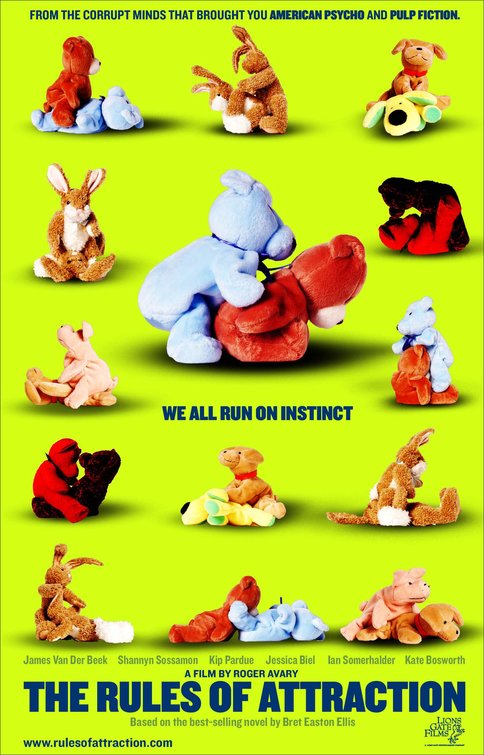Slaves and Fools for Love
The characters in Bret Easton Ellis’s The Rules of Attraction engage in promiscuous sex, an excess of alcohol and drugs, and a series of unrequited romances. The recurring ideas of sexuality, college life, love, and bourgeois lifestyle shape these students in their academic as well as social lives, so that the product of their lifestyle is their dependence on and abuse of each other. The Camden students merely act on their upper-class upbringing, devoid of any true responsibility, and therefore engage in cyclical, hedonistic acts in an effort to express and validate themselves (sexually and otherwise).
Paul’s open bisexuality and confidence in sexual prowess embodies untraditional masculinity. Barker in Cultural Studies defines modern masculinity as being associated with “performance orientation… manifested in grandiosity… and deep feelings of inadequacy and depression” (302). Paul subscribes to his privileged upbringing in that he wants outside students to know that he attends a pretentious school (Ellis, 122) and therefore only partakes in relationships that would benefit his social standing; however, with these loveless relationships he subjects himself to perpetual disappointment. Foucault’s History of Sexuality discusses the power that sex has over individuals and societies. A sexual power struggle arises in the relationship between Paul and Sean, and Foucault maintains that “pleasure and power do not cancel or turn back against one another; they seek out, overlap, and reinforce one another. They are linked together by complex mechanisms and devices of excitation and incitement” (Foucault, 690). This sexual game between Paul and Sean feeds off the pleasure as well as the ambiguity that arises in their interpretations of what happens between them (Ellis, 83-4).
Additionally, the relationship plays into the “peripheral sexualities” that Foucault discusses, which came to be correlated with a combination of both sexes found in one person (Foucault, 687). Foucault goes on to say that sexuality has evolved into another way for people to identify themselves as individuals (689); neither Paul nor Sean claim to be homosexual or bisexual, but Paul’s actions identify him as bisexual with leanings towards homosexuality and Sean’s apathy identifies him with ambiguous sexuality. Their sexual relationship may be deemed a perversion, but this is only aided by the bourgeois culture: Foucault claims that “society succeeded only in giving rise to a whole perverse outbreak” (689). Perhaps Sean’s understanding of the sexual experiences with Paul differs from Paul’s because of Sean’s confusion and/or shame regarding the sexual perversions.
In Rachel Baker’s Sigmund Freud for Everyone, one of Freud’s patients sought his guidance regarding a physical ailment of hers. A governess working for a young widower, she had to educate his two young daughters. In a session, Freud asked her if she loved the widower. She responded, “‘ it hurts my feelings to be in love with someone who considers himself superior to me, and who will never notice me’” (Baker, 51). Freud’s ideas of repression emerged from here, and he conceded that if hidden feelings are not dealt with, they can manifest in various ways, ie, obsession (Baker, 51). Sean’s confusion and rejection of homosexuality seemed to manifest itself into his obsession over Lauren, who he had falsely idealized as his admirer. Ultimately, he (like Paul) pursues relationships doomed to perpetual disappointment.
In Cultural Studies Chapter 2, Barker identifies culture as values, norms, and material or symbolic goods within a society, and Camden student identify their culture by their commodities. Jean Baudrillard’s The System of Objects how there are now so many objects by which people can personalize themselves. He dictates that advertising’s control over society creates a moral code, “[creating] a hedonistic morality of pure satisfaction” (Baudrillard, 410). The Camden students’ attendance at sexually-infused parties, pervasive with drugs and a lack of parental authority, allows for this hedonism to occur, thus perpetuating their sexual sharing cycles and spats. These students define themselves based on the people they have slept with, the drugs they enjoy, their preference for beer, the major they are registered to but disinterested in; as Baudrillard puts it, “people define themselves in relation to objects” (413). Commodities identify the three main characters: Lauren’s emptiness post-abortion defines her mundane existence (Ellis, 268), Sean’s departure from his family’s expectations explains his disappointment (Ellis, 47), and Paul’s relationship with the “slutty” Sean simplifies his existence (Ellis, 81).
But while these students ravage each other, painstakingly isolating themselves from one another, their culture cannot be deemed consumption; the authority-free, sexually liberated, intoxicated youth create the playground for consumption of one another. By giving everything to them, society cultivated this generation of upper-class yuppie youth into hedonists with latent morality.
Works CitedBaker, Rachel. Sigmund Freud for Everybody. London: Popular Library, 1963. Print.
Barker, Chris. Cultural Studies: Theory and Practice. London: Sage Publications. 2008. Print.
Ellis, Bret Easton. The Rules of Attraction. New York: Vintage Books. 1987. Print.
Rivkin, Julie and Michael Ryan, eds. Rivkin, Julie and Michael Ryan. “The Politics of Culture” Literary Theory: An Anthology. Malden: Blackwell, 1998.
Rivkin, Julie and Michael Ryan, eds. Baudrillard, Jean. "The System of Objects." Literary Theory: An Anthology. Malden: Blackwell, 1998.
Rivkin, Julie and Michael Ryan, eds. Foucault, Michel. "The History of Sexuality." Literary Theory: An Anthology. Malden: Blackwell, 1998.

No comments:
Post a Comment